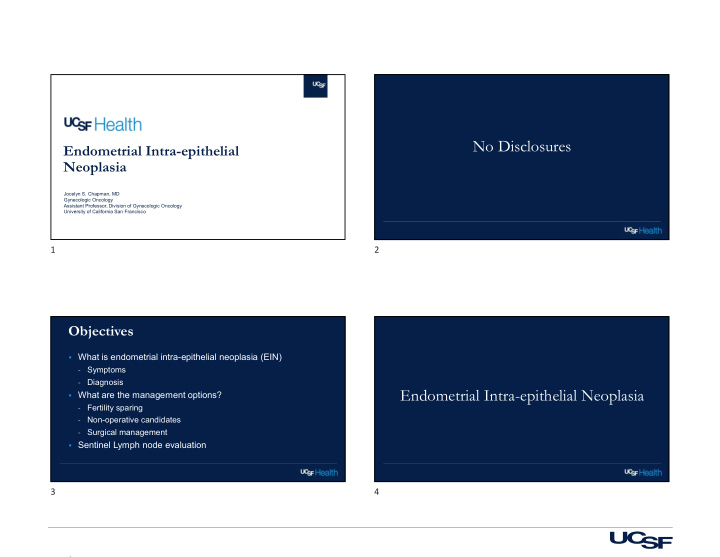



No Disclosures Endometrial Intra-epithelial Neoplasia Jocelyn S. Chapman, MD Gynecologic Oncology Assistant Professor, Division of Gynecologic Oncology University of California San Francisco 1 2 Objectives What is endometrial intra-epithelial neoplasia (EIN) Symptoms - Diagnosis - Endometrial Intra-epithelial Neoplasia What are the management options? Fertility sparing - Non-operative candidates - Surgical management - Sentinel Lymph node evaluation 3 4 1
ACOG – Committee Opinion May 2015 ACOG – Committee Opinion May 2015 5 6 Prognostic accuracy of EIN Risk factors for EIN 7 8 2
Risk factors for EIN Signs & Symptoms Bleeding OBESITY Present in 90% of all cases - 21-50lb overweight – 3x incidence - 15% of patients with postmenopausal bleeding will have endometrial cancer - >50lb weight - 10x incidence - Other Signs/Symptoms Nulliparity – incidence increased 2x Vaginal Discharge - Late Menopause - incidence increased 2.5x Pelvic Pain, Pressure - Diabetes, hypertension, hypothyroidism are associated Referred Leg Pain - with endometrial cancer Change in Bowel Habits - Pyometria/Hematometria - 9 10 Diagnosis Pap Smear Only 30-50% patients with cancer will have an abnormal result - AGUS predictive of carcinoma in post-menopausal women - Endometrial Biopsy Management of EIN False negative rate of 5-10% - Trans-vaginal Ultrasound Not for routine screening or diagnosis (unless Lynch) - Suspicious findings include endometrial stripe >5mm, polypoid mass, or fluid - collection in uterus 11 12 3
Non-surgical management Consider MRI Candidates - Benign endometrial hyperplasia - EIN PLUS Desired fertility No evidence of concomitant carcinoma Non-operative candidates 13 14 Non-surgical management Progestins Non-pharmacologic interventions - Removal of source of unopposed estrogen Correct ovulatory dysfunction Weight loss Estrogen producing neoplasms (i.e. granulosa cell tumors) Progestin therapy 15 16 4
LNG-IUD compared to MPA Monitoring & Regression Repeat EMB q3-6 months until regression If menses resumes (for pre-menopausal patients), no further biopsy necessary If EIN persists – add megace to LNG-IUD If EIN persists despite dual agent therapy, patient has failed conservative management and should SH = simple hyperplasia, CH = complex hyperplasia, ACH = atypical complex hyperplasia be recommended for hysterectomy Orbo A, Vereide A, Arnes M, Pettersen I, Straume B. Levonorgestrel-impregnated intrauterine device as treatment for endometrial hyperplasia: a national multicentre randomised trial. BJOG. 2014 Mar;121(4):477-86. 17 18 Risk of Lymph Node Metastases Role of Sentinel Lymph Node Evaluation 19 20 5
SLN Mapping in Uterine Cancer Sentinel Lymph Node Mapping with ICG Abu-Rustum. Sentinel Lymph node mapping https://doi.org/10.6004/jnccn.2014.0026 21 22 SLN Algorithm Risks associated with lymphadenectomy Sentinel lymph node (SLN) mapping algorithm. Abbreviation: LND, lymph node dissection.From Barlin JN, Khoury-Collado F, Kim CH, et al. The importance of applying a sentinel lymph node mapping algorithm in endometrial cancer staging: beyond removal of blue nodes. Gynecol Oncol 2012;125:534; with permission. 23 24 6
Lymph node assessment risk for EIN Proposed protocol for EIN management with GYN and GYNONC 43% with EIN will have cancer on hysterectomy EIN or FIGO grade 1 endometrioid specimen. adenocarcinoma 12% of cancers diagnosed pre-op as EIN will have Pre-operative CT A/P and CXR (for FIGO grade 1) deeply invasive, high-grade tumors Pre-operative ultrasound (for EIN) 7% of patients staged at the time of hysterectomy with a CXR pre-operative diagnosis of EIN have nodal metastatic disease If BMI > 40 must refer to GynOnc Cancer. 2006 Feb;106:812-9. Int J Gynecol Cancer. 2005 Jan-Feb;15:127-31. 25 26 Review Questions Review Questions What is one advantage of the endometrial intraepithelial Which of the following describes a patient who can be neoplasia (EIN) diagnostic schema over the WHO94 offered non-operative management of her EIN? schema? 78% 95% A. A 47 year old woman who has had 4 A. EIN classification is more reproducible endometrial biopsies over 2 years with B. EIN classification has been used longer persistent EIN while on progestin therapy. C. EIN classification is preferred by 16% B. A 28 year old woman who desires 6% 3% 2% pathologists pregnancy and has an MRI without evidence of invasive carcinoma. C. A 66 year old woman with class 3 obesity. 27 Presentation Title 28 Presentation Title 27 28 7
Review Questions Review Questions Which of the following progestins appears to be most What is the risk of lymphedema after a pelvic efficacious in regression of EIN? lymphadenectomy? 90% 85% A. Medroxyprogesterone acetate A. 5% B. Levonorgesterol intra-uterine device B. 10% C. Megace 180mg BID C. 20% 8% 2% 8% 7% 29 Presentation Title 30 Presentation Title 29 30 Questions? Thank you! 31 8
Recommend
More recommend